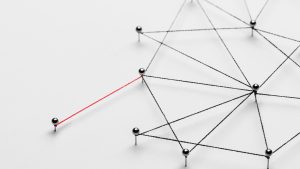Have you ever tried tiered linking?
For the uninitiated, tiered linking is when you share content that has links to a post with links to your website.
That sounds a bit confusing, isn’t it?
Say, for example, that A has links to your client’s website. You create a social media post, B, with links to A. You then go on to make another post with links to B.
Link Building is a valid strategy to increase authority, whereas tiered linking may have its problems.
This isn’t to say that tiered links don’t deliver. They absolutely do. But if you don’t take care, things can quickly go south.
- Guest post on industry blogs and include 1-2 relevant links in the author bio. Make sure the content provides value for readers.
- Sponsor or donate to a responsible gambling charity and get a link in return.
- Comment on forums and articles in your niche, offering useful insights along with a site link. Don’t spam.
- Get interviewed as an expert on gambling sites and podcasts. Mention your site contextually if asked.
- Create social media profiles and engage regularly with valuable info. Include site link in bio.
- Publish and promote an ebook, research or stats on the industry with 1-2 attribution links.
- Start an ethical affiliate program and have partners link to your site from theirs.
- Reach out to local casinos and gambling venues to be listed as a recommended responsible site.
The focus should be on building reputation by providing genuine value to users first rather than just seeking links. Links should occur naturally and ethically as part of that process. Aggressive/manipulative link building tactics should be avoided.
In this article, I have only discussed second-tier links because you run the risk of getting penalized by Google if you go above second-tier linking.
What Are Second-Tier Links?
As said earlier, tiered linking is when you create posts or websites with the intention of linking to posts that have links to your actual website.
First-tier links are the links you find in posts (social media or blogs) that redirect the visitor to your website.
Second-tier links boost first-tier links. These are the links that point to pages with links to your website, aka first-tier links.
You can find second-tier links in just about anything, from social media posts, articles, and emails to directories and forums.
So, what benefit do second-tier links provide?
The main advantage of second-tier links is that they improve your website’s backlink profile. A better backlink profile increases the authoritativeness of your website. The more domain authority your website has, the better its search ranking.
And finally, a better search ranking means more visibility, which means increased traffic.
This is why you shouldn’t ignore second-tier links when building a backlink profile.
Tiered linking follows the concept of link equity, which is explained below.

Link Equity
When one webpage links to another, some of the first page’s authority is passed on to the second page. This is called link equity.
In simple terms, when page A links to page B, page B gets some of page A’s authority.
This is why marketers go after websites with high domain authority (DA) to build a website’s backlink profile.
Another name for link equity is “link juice,” since the DA flows from one page to another, improving the rankings of everything along the way.
With that out of the way, let’s discuss the ideal spots to place second-tier links.
Guest Posts
Guest posts are created for two reasons alone: one, to post your links, and two, to educate visitors on a certain topic.
Guest posts are the most commonly used tools when it comes to link building. You find a website relevant to your niche, request that they post an article with a link to your website, and, if they agree, post an article with a link back to your website.
You can also promote your guest posts this way. Just create additional posts that link back to your original guest post with a link to your website.
Secondary Website
You can place links to your main website on your secondary website(s). In other words, just create a blog post on your secondary website and include a link to your primary website.
You must also make sure that the websites that link to your primary website belong to the same niche, as Google will find it fishy if your website has multiple backlinks from sites that are irrelevant to your niche.

Social Bookmark Links
Social bookmarking is a phenomenon where websites have dedicated, organized forums for discussions and resource sharing. Social bookmarking sites allow visitors to engage with people with similar interests or professions.
Social bookmarking websites are great for sharing your second-tier links, considering the exorbitant number of people who use them.
Social Media
Just a heads up, social media links are nofollow, meaning they don’t contribute anything in terms of SEO.
But links in social media posts are great for one thing, exposure. They’re great at promoting guest posts with first- and second-tier links.
And, on top of that, social media links also help Google index content better.
Link Exchanges
It is exactly what it sounds like. Link exchanges are when two websites agree to link to each other with the objective of improving SEO rankings.
Google guidelines have given the green light for link exchanges, but only to a certain extent.
The link exchange strategy is great for second-tier links since you won’t directly link your website but to a post with the link, considerably reducing the chances of a Google penalty.
Forums
Forums are private, heavily moderated, and come with their own set of rules. The reason I say this is because if you’re directly promoting a post with your link, the moderators will flag you. Even if the moderators miss it, the members will report you.
At times like this, second-tier links are a lifesaver. Because, you’re not directly linking your website.
Another thing to keep in mind when posting in forums is relevance. Post your second-tier links on relevant forums, as most forums have strict rules against spamming and self-promotion.
Now that you’ve read what you can (or should) do, here are a few things you shouldn’t do.
Link Schemes
A Link Scheme is a strategy where marketers create websites, relationships, and processes for backlinking.
This is problematic because the websites that link to your pages don’t have any other purpose. They’re there only to post your links.
Also, Google penalizes websites that are involved in link schemes.
Relevance
Although Domain Authority (DA) and Domain Rating (DR) are important factors to measure the strength of a website’s backlinks, you can’t ignore relevance.
Google will find out if your website has multiple links from websites that are outside your niche. And when that happens, your website will be handed a Google Manual Penalty.
Spamming
Spamming is, was, and will never be a good strategy for anything, especially SEO. That’s why it’s recommended to include links to your original post just once in your secondary post.
Take the case of email. You’re using an email for second-tier link building and have mentioned the links twice; Gmail will happily group your email under the promotions tab.
To wrap things up, link building is a viable strategy for SEO. Not only does it contribute to better website traffic, but it also improves your page and domain authority.
Just like every other thing, there are ways to speed up the process for quick results. But their consequences make them not worth it.
Second-tier links are something like that. Use it just the right amount, and you’re fine. Abuse it and face the consequences.
When executed correctly, second-tier links can do a world of good for your primary website, both in terms of traffic and ranking.










